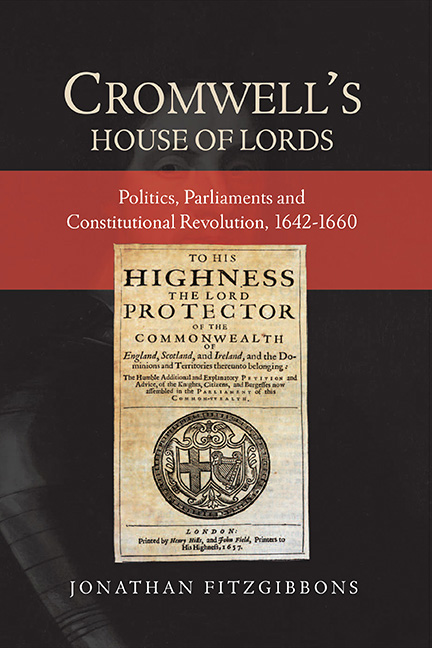Book contents
- Frontmatter
- Contents
- Acknowledgements
- Abbreviations
- Introduction
- 1 Parliamentarian Thought and the Abolition of the House of Lords, 1642–49
- 2 Oliver Cromwell, the Other House and the Humble Petition and Advice
- 3 The Membership of the Other House
- 4 The Other House and the Second Session of the Second Protectorate Parliament
- 5 Richard Cromwell, the Third Protectorate Parliament and the Other House Debates
- 6 The Other House, the Army and the Search for a Settlement
- Conclusion
- Appendix: The Membership of the Other House
- Bibliography
- Index
- Studies in Early Modern Cultural, Political and Social History
Appendix: The Membership of the Other House
Published online by Cambridge University Press: 05 May 2018
- Frontmatter
- Contents
- Acknowledgements
- Abbreviations
- Introduction
- 1 Parliamentarian Thought and the Abolition of the House of Lords, 1642–49
- 2 Oliver Cromwell, the Other House and the Humble Petition and Advice
- 3 The Membership of the Other House
- 4 The Other House and the Second Session of the Second Protectorate Parliament
- 5 Richard Cromwell, the Third Protectorate Parliament and the Other House Debates
- 6 The Other House, the Army and the Search for a Settlement
- Conclusion
- Appendix: The Membership of the Other House
- Bibliography
- Index
- Studies in Early Modern Cultural, Political and Social History
Summary
Key to Appendix
Name
The 62 members of the Other House arranged in alphabetical order by surname.
Sources: HMC Lords, pp. 503–4; BL, Sloane MS 3246; TNA, C218/1/34.
Title(s)
Titles held by the members of the Other House at the time of their nomination. Sources: G.E.C., Peerage; ODNB; Perfect Politician; Noble, Memoirs of the Protectoral-House.
Social Status
Social status of the membership at the outbreak of the Civil Wars. These categories are largely based upon the important studies of parliamentary membership in the 1640s and 1650s by Jones, Underdown and Woolrych.
GG = Aristocracy or greater gentry
CG = Country gentry
LG = Lesser gentry
MG = Merchant gentry
BG = Below gentry
? = Unknown
Sources: Jones, ‘Composition and Activity of the Protectorate Parliaments’; ODNB; Underdown, Pride's Purge, pp. 361–98; Woolrych, Commonwealth to Protectorate, pp. 403–33.
Age
The age of each member at the time of their summons to the Other House in 1657.
Sources: G.E.C., Peerage; ODNB.
Attendance
Indicates whether the members attended the Other House at any point during the second session of the second Protectorate Parliament (1658) and the third Protectorate Parliament (1659).
‘P’ = Present.
‘X’ = Dead or Removed.
Sources: HMC Lords, pp. 503–67; Mus. of Lon., Tangye MS 11a, fols 1–61.
Politics
‘C’ = Civilian Cromwellian
‘C?’ = Probable Civilian / Conservative
‘M’ = Military Cromwellian
‘M?’ = Probable Military
‘R’ = Republican
‘?’ = Unknown
A ‘(k)’ has been added to the names of those identified as voting for kingship in A Narrative of the late Parliament (so called), pp. 22–3. The method of classification is discussed in more detail in Chapter 3.
Officers
Rank of members who were serving officers in 1657–59 and the number of regiments they commanded.
Sources: Firth & Davies, The Regimental History of Cromwell's Army. Previous Parliaments \
Those old peers who had sat in the House of Lords prior to its dissolution are listed as members of the Long Parliament.
‘LP’ = MP in Long Parliament
‘RP’ = MP in Rump Parliament
‘BP’ = Member of Barebone's Parliament
‘1PP’ = MP in First Protectorate Parliament
‘2PP’ = MP in Second Protectorate Parliament.
- Type
- Chapter
- Information
- Cromwell's House of LordsPolitics, Parliaments and Constitutional Revolution, 1642–1660, pp. 239 - 246Publisher: Boydell & BrewerPrint publication year: 2018

